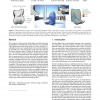Free Online Productivity Tools
i2Speak
i2Symbol
i2OCR
iTex2Img
iWeb2Print
iWeb2Shot
i2Type
iPdf2Split
iPdf2Merge
i2Bopomofo
i2Arabic
i2Style
i2Image
i2PDF
iLatex2Rtf
Sci2ools
SIGGRAPH
2010
ACM
2010
ACM
Paneling architectural freeform surfaces
The emergence of large-scale freeform shapes in architecture poses big challenges to the fabrication of such structures. A key problem is the approximation of the design surface by a union of patches, socalled panels, that can be manufactured with a selected technology at reasonable cost, while meeting the design intent and achieving the desired aesthetic quality of panel layout and surface smoothness. The production of curved panels is mostly based on molds. Since the cost of mold fabrication often dominates the panel cost, there is strong incentive to use the same mold for multiple panels. We cast the major practical requirements for architectural surface paneling, including mold reuse, into a global optimization framework that interleaves discrete and continuous optimization steps to minimize production cost while meeting user-specified quality constraints. The search space for optimization is mainly generated through controlled deviation from the design surface and tolerances on ...
Architectural Surface Paneling | Computer Graphics | Design Surface | Large-scale Freeform Shapes | SIGGRAPH 2010 |
| Added | 28 Jul 2010 |
| Updated | 29 Jul 2010 |
| Type | Conference |
| Year | 2010 |
| Where | SIGGRAPH |
| Authors | Michael Eigensatz, Martin Kilian, Alexander Schiftner, Niloy J. Mitra, Helmut Pottmann, Mark Pauly |
Comments (0)

